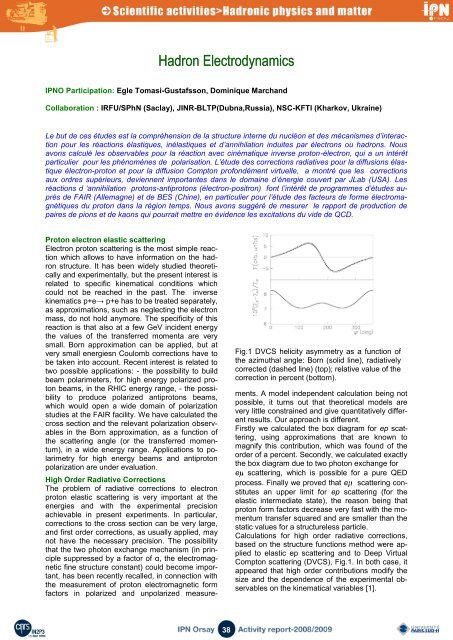exotic nuclei structure and reaction noyaux exotiques ... - IPN - IN2P3
exotic nuclei structure and reaction noyaux exotiques ... - IPN - IN2P3
exotic nuclei structure and reaction noyaux exotiques ... - IPN - IN2P3
You also want an ePaper? Increase the reach of your titles
YUMPU automatically turns print PDFs into web optimized ePapers that Google loves.
Hadron Electrodynamics<br />
<strong>IPN</strong>O Participation: Egle Tomasi-Gustafsson, Dominique March<strong>and</strong><br />
Collaboration : IRFU/SPhN (Saclay), JINR-BLTP(Dubna,Russia), NSC-KFTI (Kharkov, Ukraine)<br />
Le but de ces études est la compréhension de la <strong>structure</strong> interne du nucléon et des mécanismes d’interaction<br />
pour les réactions élastiques, inélastiques et d’annihilation induites par électrons ou hadrons. Nous<br />
avons calculé les observables pour la réaction avec cinématique inverse proton-électron, qui a un intérêt<br />
particulier pour les phénomènes de polarisation. L’étude des corrections radiatives pour la diffusions élastique<br />
électron-proton et pour la diffusion Compton profondément virtuelle, a montré que les corrections<br />
aux ordres supérieurs, deviennent importantes dans le domaine d’énergie couvert par JLab (USA). Les<br />
réactions d ‘annihilation protons-antiprotons (électron-positron) font l’intérêt de programmes d’études auprès<br />
de FAIR (Allemagne) et de BES (Chine), en particulier pour l’étude des facteurs de forme électromagnétiques<br />
du proton dans la région temps. Nous avons suggéré de mesurer le rapport de production de<br />
paires de pions et de kaons qui pourrait mettre en évidence les excitations du vide de QCD.<br />
Proton electron elastic scattering<br />
Electron proton scattering is the most simple <strong>reaction</strong><br />
which allows to have information on the hadron<br />
<strong>structure</strong>. It has been widely studied theoretically<br />
<strong>and</strong> experimentally, but the present interest is<br />
related to specific kinematical conditions which<br />
could not be reached in the past. The inverse<br />
kinematics p+e→ p+e has to be treated separately,<br />
as approximations, such as neglecting the electron<br />
mass, do not hold anymore. The specificity of this<br />
<strong>reaction</strong> is that also at a few GeV incident energy<br />
the values of the transferred momenta are very<br />
small. Born approximation can be applied, but at<br />
very small energiesn Coulomb corrections have to<br />
be taken into account. Recent interest is related to<br />
two possible applications: - the possibility to build<br />
beam polarimeters, for high energy polarized proton<br />
beams, in the RHIC energy range, - the possibility<br />
to produce polarized antiprotons beams,<br />
which would open a wide domain of polarization<br />
studies at the FAIR facility. We have calculated the<br />
cross section <strong>and</strong> the relevant polarization observables<br />
in the Born approximation, as a function of<br />
the scattering angle (or the transferred momentum),<br />
in a wide energy range. Applications to polarimetry<br />
for high energy beams <strong>and</strong> antiproton<br />
polarization are under evaluation.<br />
High Order Radiative Corrections<br />
The problem of radiative corrections to electron<br />
proton elastic scattering is very important at the<br />
energies <strong>and</strong> with the experimental precision<br />
achievable in present experiments. In particular,<br />
corrections to the cross section can be very large,<br />
<strong>and</strong> first order corrections, as usually applied, may<br />
not have the necessary precision. The possibility<br />
that the two photon exchange mechanism (in principle<br />
suppressed by a factor of α, the electromagnetic<br />
fine <strong>structure</strong> constant) could become important,<br />
has been recently recalled, in connection with<br />
the measurement of proton electromagnetic form<br />
factors in polarized <strong>and</strong> unpolarized measure-<br />
Fig.1 DVCS helicity asymmetry as a function of<br />
the azimuthal angle: Born (solid line), radiatively<br />
corrected (dashed line) (top); relative value of the<br />
correction in percent (bottom).<br />
ments. A model independent calculation being not<br />
possible, it turns out that theoretical models are<br />
very little constrained <strong>and</strong> give quantitatively different<br />
results. Our approach is different.<br />
Firstly we calculated the box diagram for ep scattering,<br />
using approximations that are known to<br />
magnify this contribution, which was found of the<br />
order of a percent. Secondly, we calculated exactly<br />
the box diagram due to two photon exchange for<br />
e scattering, which is possible for a pure QED<br />
process. Finally we proved that e scattering constitutes<br />
an upper limit for ep scattering (for the<br />
elastic intermediate state), the reason being that<br />
proton form factors decrease very fast with the momentum<br />
transfer squared <strong>and</strong> are smaller than the<br />
static values for a <strong>structure</strong>less particle.<br />
Calculations for high order radiative corrections,<br />
based on the <strong>structure</strong> functions method were applied<br />
to elastic ep scattering <strong>and</strong> to Deep Virtual<br />
Compton scattering (DVCS), Fig.1. In both case, it<br />
appeared that high order contributions modify the<br />
size <strong>and</strong> the dependence of the experimental observables<br />
on the kinematical variables [1].<br />
38

















